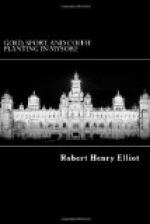The western group, Mr. Foote tells us, is far poorer in auriferous localities than either of the others, and they are scattered widely apart. He examined in all seven localities. Of the first locality examined, he says that the geological features are all favourable to the occurrence of gold, and that the locality is worthy of very careful prospecting. In locality number two, such a good show of coarse grained gold was got from the sands of a stream that he thought a portion of the land from which its water came ought to be closely tested in order to trace the source of the gold found in the stream. When writing on locality number three, Mr. Foote observes that the elevated tract of the auriferous rocks of which the Bababudan mountains form the centre is one well deserving great attention both from the geologist and the mining prospector, it being an area of great disturbance, the rocks being greatly contorted on a large scale and, the north and south sides at least of the area, much cut up by great faults. The whole of the auriferous areas here, he says, are deserving of close survey, for even the best of them are very imperfectly known, and much of what was known to the old miners in former generations has been forgotten. “From the fact,” writes Mr. Foote, “that in my hurried tour I came upon no less than five sets of old workings that had not been brought under the notice of Messrs. Lavelle and Marsh (reports of whose investigations are given in the “Selections"), I quite expect to hear that many other old abandoned workings exist in wild and jungly tracts which bound in the hilly and mountainous parts of the country.” In locality number five such fine shows of gold were obtained, and there was such a good looking old mine, and quartz reefs of great size, that Mr. Foote considered the place deserving of “very marked attention from earnest prospectors.”
It is evident, from what Mr. Foote has said, that there is much to be done in the way of exploring and testing the Mysore province for gold, and I hope that what I have written may be the means of attracting further attention to the subject.
At the close of his report Mr. Foote mentions the fact that “a great dyke of beautiful porphyry traverses the hills east of the Karigatta temple overlooking Seringapatam. The porphyry, which is of warm brown or chocolate colour, includes many crystals of lighter coloured felspar, and dark crystals of hornblende. The stone would take a very high polish, and for decorative purposes of high class, such as vases, panels and bases for busts and tazzas, etc., it is unequalled in South India, and deserving of all attention. If well polished it fully equals many of the highly prized antique porphyries. The dyke is of great thickness and runs for fully a mile, so is practically inexhaustible. Blocks of very large size could be raised, and from the situation of the dyke on the side of two steep hills, it would be very easy to open up large quarries if needful.” As this dyke is close to a railway it may be worthy of the attention of capitalists.




